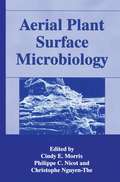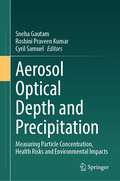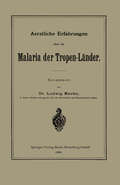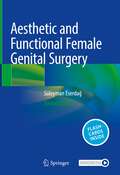- Table View
- List View
Advocacy in Health Care: The Power of a Silent Constituency (Contemporary Issues in Biomedicine, Ethics, and Society)
by Joan H. MarksThe roles of both the consumer and the health advocate professional have become increasingly significant in to day's climate of "rationed" health care. It seems clear that the timely exchange of ideas among seasoned health care advocates is necessary if we are to deal with the complex problems of a technologically advanced so ciety seeking to ration its heath care in a truly humane way. Toward such a timely exchange, the first Confer ence on Advocacy in Health Care was organized by the Health Advocacy Program of Sarah Lawrence College and recently held. Advocacy in Health Care: The Power of a Silent Constituency is the proceedings of the conference and will, we believe, greatly extend our efforts to share both the problems and solutions that effective patient advocacy entails. Never before has the issue of advocating for special population groups by combining the resources of consumers and professionals been the exclusive focus of one volume. This book discusses the power of such an alignment and describes specific organizational techniques that have been effective in bringing about changes in the delivery system. The final section of the book, "Questions, Com ments and Answers," presents a selection of topics of special interest that surfaced during the open disc- vii viii Preface sion at the last conference session. The comments were forthright in their criticism of public policy, and the vigor of the argument underscored the vitality of the co alition between professionals and consumers.
Advocacy in Neurology
by Wolfgang Grisold Walter Struhal Thomas GrisoldAdvocacy is a broad term that covers activities aimed at increasing attention, awareness, information, nursing, treatment, and support to improve the outcome of patients. These actions can be focused directly towards patients or indirectly via third parties. Although advocacy is present in all medical specialties, neurology in particular finds itself in need of strong advocacy tools as the diagnosis, treatment, long-term care and associated resource, and social issues have become increasingly complex. While some physicians implicitly or explicitly act as advocates, there is a lack of holistic research in order to clarify the meaning of advocacy along with concrete methods and strategies. Advocacy in Neurology provides an integrated approach to the concept of advocacy in neurology. Structured in five sections, the book begins by explaining the term "advocacy" in general before elaborating on the areas of interest within neurology. The text goes on to offer concrete strategies and tools for clinicians to deploy advocacy in their daily work, and then discusses specific neurological diseases to point out and explain where advocacy is, or could be, beneficial. The book ends with an outlook, presentation of results, and an ending conclusion. Advocacy in Neurology offers a practical perspective on advocacy activities in neurology, aiming to show when and why they are important for neurology.
Advocacy in Neurology
Advocacy is a broad term that covers activities aimed at increasing attention, awareness, information, nursing, treatment, and support to improve the outcome of patients. These actions can be focused directly towards patients or indirectly via third parties. Although advocacy is present in all medical specialties, neurology in particular finds itself in need of strong advocacy tools as the diagnosis, treatment, long-term care and associated resource, and social issues have become increasingly complex. While some physicians implicitly or explicitly act as advocates, there is a lack of holistic research in order to clarify the meaning of advocacy along with concrete methods and strategies. Advocacy in Neurology provides an integrated approach to the concept of advocacy in neurology. Structured in five sections, the book begins by explaining the term "advocacy" in general before elaborating on the areas of interest within neurology. The text goes on to offer concrete strategies and tools for clinicians to deploy advocacy in their daily work, and then discusses specific neurological diseases to point out and explain where advocacy is, or could be, beneficial. The book ends with an outlook, presentation of results, and an ending conclusion. Advocacy in Neurology offers a practical perspective on advocacy activities in neurology, aiming to show when and why they are important for neurology.
AE-Manual der Endoprothetik: Schulter
by Markus LoewDer Band ist Teil des „Manuals der Endoprothetik" und vermittelt in umfassender, verständlicher Form sowohl Basis- als auch Expertenwissen. Gut strukturiert und reich bebildert, enthält der Band alle wichtigen Informationen zur Entwicklung der Schulterendoprothetik. Die operativen Zugänge werden schrittweise dargestellt, einschließlich operativer Tipps und Tricks bei speziellen Indikationen wie rheumatische Gelenkzerstörung oder Nekrose. Darüber hinaus werden auch die unterschiedlichen Prothesenmodelle ausführlich behandelt.
AE-Manual der Endoprothetik: Hüfte und Hüftrevision
by Lutz Claes, Peter Kirschner, Carsten Perka and Maximilian RudertErfahrene Autoren vermitteln in dem Band umfassendes Basis- und Expertenwissen zur Hüftendoprothetik. Neben der Entwicklung der Alloarthroplastik, Biomechanik, Design, Werkstoffen und Tribologie wird insbesondere die Operationstechnik bei primären und sekundären Coxarthrosen, hüftnahen Tumoren sowie bei der Revision gelockerter und infizierter Endoprothesen dargestellt und mit zahlreichen Abbildungen verständlich gemacht. Der Band ist Teil des Gesamtwerks „Manual der Endoprothetik“, herausgegeben von der Arbeitsgemeinschaft Endoprothetik.
AE-Manual der Endoprothetik: Sprunggelenk und Fuß
by Hans Wolfram NeumannDer Band zur Endoprothetik des Sprunggelenks und des Fußes ist Teil des Gesamtwerks „Manual der Endoprothetik“. Die Endoprothetik an Sprunggelenk und Fuß hat sich wegen der besonderen Biomechanik und Anatomie langsam und nur an wenigen Kliniken entwickelt. Im Mittelpunkt des Buchs stehen die Operationstechniken für die Prothesenimplantation und für die Alternativen der Osteotomie und Arthrodese. Der Band enthält eine Darstellung der unterschiedlichen Prothesenmodelle sowie viele praktische Hinweise zur postoperativen Therapie und Rehabilitation.
AE-Manual der Endoprothetik: Knie
by Dieter Christian WirtzDie Implantation einer Knieendoprothese gilt heute als Standardoperation, dennoch erfordert sie eine anspruchsvolle Operationstechnik. Der Band, autorisiert von der Arbeitsgemeinschaft Endoprothetik, bietet Hilfestellung bei der Auswahl des Prothesenmodells, präoperative Planung und Operationstechnik werden in Schritt-für-Schritt Anleitungen in Text und Bild dargestellt. Darüber hinaus dient das Manual als Leitfaden für die postoperative Behandlung und das Komplikationsmanagement. Aspekte der Revisionschirurgie finden besondere Beachtung.
AE-Manual der Endoprothetik: Ellenbogen
by Wolfgang Rüther and Beat R. SimmenDer Band zur Endoprothetik des Ellenbogens ist der vorläufig letzte Teil des Gesamtwerkes Manual der Endoprothetik, herausgegeben von der Arbeitsgemeinschaft Endoprothetik. Der prothetische Ersatz des Ellenbogengelenkes ist der am seltensten durchgeführte Gelenkersatz der großen Gelenke an oberen und unteren Extremitäten. Die funktionellen Kompensationsmöglichkeiten der Patienten, der weniger weit fortgeschrittene Entwicklungsstand der Ellenbogenprothetik im Vergleich zur Hüft- und Kniearthroplastik, die technischen Probleme bei der Operation selbst mit höherer Komplikationsrate und den äußerst anspruchsvollen Rückzugsmöglichkeiten beim Versagen sind die Ursachen. Dies gilt für alle bisher vorgestellten Designvariationen der Ellenbogenkunstgelenke. Gründe für das frühere und häufigere Versagen liegen in der besonderen Anatomie und Biomechanik des Ellenbogengelenkes und den damit verbundenen Konsequenzen für die Leistungsfähigkeit eines Kunstgelenkes. Auf diese Probleme wird in diesem Band eingegangen. Indikationsstellung, Operationstechnik, alternative Verfahren, frühe und späte Komplikationen, deren Behandlung, und Rückzugsmöglichkeiten werden dargelegt. Mittel- und längerfristige Ergebnisse werden diskutiert. Die beschränkten ossären Reserven des Ellenbogenknochenlagers, die Klippen und Tücken der Ellenbogenarthroplastik werden ersichtlich und mögen sowohl Anleitung sein als auch die Möglichkeiten und ihre Grenzen aufzeigen. Empfehlungen zur postoperativen Nachbehandlung und Rehabilitation ergänzen den Band. Nationale und internationale Erfahrungen sind zu dieser Standortbestimmung zusammengeführt.
Aerial Plant Surface Microbiology
by Cindy E. Morris Philippe C. Nicot Christophe Nguyen-The''Informative, well-constructed, and readable...The contributors are leaders in their fields and what they have to say is worthwhile.'' --- SGM Quarterly, August 1998
Aerodynamics of Tandem Wing Aircraft: From Dinosaurs to UAVs and Supersonic Planes
by Illia KryvokhatkoThis book contains extensive data about tandem wing aircraft. It includes a review of modern flying vehicles with four fixed wings, a review of analytical, numerical and experimental methods; results of the studies about aerodynamics; dependencies between geometrical parameters and aerodynamic characteristics, practical recommendations in development and optimizing of tandem wing aircraft to provide high lift-to-drag ratio, stability, and controllability. This is an ideal book for graduate students, researchers, and engineers working in fields of aerodynamics and conceptual design of the aircraft especially UAVs, ground-effect vehicles, and convertiplanes.
Aeromedical Evacuation: Management of Acute and Stabilized Patients
by P. K. Jr. Carlton William W. Hurd John G. JerniganThe definitive treatment on the medical evacuation and management of injured patients in both peace- and wartime. Edited by eminent experts in the field, this text brings together medical specialists from all four branches of the armed services. It discusses the history of aeromedical evacuation, triage and staging of the injured patient, evacuation from site of injury to medical facility, air-frame capabilities, medical capabilities in-flight, response to in-flight emergencies, and mass emergency evacuation. Specific medical conditions are addressed in detail, including such general surgical casualties as abdominal wounds and soft tissue, vascular, maxillofacial, head and spinal cord injuries, ophthalmologic, orthopaedic, pediatric, obstetric-gynecologic casualties, burns, and more. Over 80 illustrations provide a review of transport equipment and both medical and surgical treatment. A must-have reference for all armed forced physicians and flight surgeons, for general and trauma surgeons, internists, intensive care specialists, orthopaedic surgeons, and public health service physicians.
Aeromedical Evacuation: Management of Acute and Stabilized Patients
by William W. Hurd William BeninatiThe definitive treatment on the medical evacuation and management of injured patients in both peace- and wartime. Edited by eminent experts in the field, this text brings together medical specialists from all four branches of the armed services. It discusses the history of aeromedical evacuation, triage and staging of the injured patient, evacuation from site of injury to medical facility, air-frame capabilities, medical capabilities in-flight, response to in-flight emergencies, and mass emergency evacuation. Specific medical conditions are addressed in detail, including such general surgical casualties as abdominal wounds and soft tissue, vascular, maxillofacial, head and spinal cord injuries, ophthalmologic, orthopaedic, pediatric, obstetric-gynecologic casualties, burns, and more. Over 80 illustrations provide a review of transport equipment and both medical and surgical treatment. A must-have reference for all armed forced physicians and flight surgeons, for general and trauma surgeons, internists, intensive care specialists, orthopaedic surgeons, and public health service physicians.
Aeromedical Transportation: A Clinical Guide
by T. MartinStill the only book published anywhere in the world which is devoted entirely to the principles of aeromedical transport, Aeromedical Transportation has rightly become known as the sole reference for the industry. This second edition has been radically revised and updated; featuring the latest research, updated references and new chapters on the transport of intensive care patients, and medical emergencies/death in flight. Since the first edition was published in 1996, the concept of 'evidence-based medicine' has been accepted as essential in any book which endeavours to be the accepted knowledge base in its subject area. A very practical text, international in its approach, much of its content is devoted to clinical matters. Administration and organisation are also discussed, but are addressed from the standpoint of the clinical aeromedical escort. The text is suitable for medical, paramedical and nursing personnel and for those working in organizations whose duties include the transportation of the sick and injured by air.
Aeromedical Transportation: A Clinical Guide
by T. MartinStill the only book published anywhere in the world which is devoted entirely to the principles of aeromedical transport, Aeromedical Transportation has rightly become known as the sole reference for the industry. This second edition has been radically revised and updated; featuring the latest research, updated references and new chapters on the transport of intensive care patients, and medical emergencies/death in flight. Since the first edition was published in 1996, the concept of 'evidence-based medicine' has been accepted as essential in any book which endeavours to be the accepted knowledge base in its subject area. A very practical text, international in its approach, much of its content is devoted to clinical matters. Administration and organisation are also discussed, but are addressed from the standpoint of the clinical aeromedical escort. The text is suitable for medical, paramedical and nursing personnel and for those working in organizations whose duties include the transportation of the sick and injured by air.
Aerosol Inhalation: Prodeedings of the International Workshop on Aerosol Inhalation, Lung Transport, Deposition and the Relation to the Environment: Recent Research Frontiers, Warsaw, Poland, September 14–16, 1995
by J. C. M. Marijnissen and L. GradońA group of highly esteemed aerosol scientists - physicists, chemists, biologists and toxicologists - met in Warsaw in September, 1995, in order to discuss the latest developments in the field of aerosol health subjects, including inhalation, lung transport and deposition. The relationship of these subjects with the environment was also addressed. This book contains the proceedings of the Workshop and also documents the ensuing panel discussions. Subject Index included.
Aerosol Optical Depth and Precipitation: Measuring Particle Concentration, Health Risks and Environmental Impacts
by Sneha Gautam Cyril Samuel Roshini Praveen KumarThis volume uses aerosol optical depth (AOD) analysis through mapping and remote sensing techniques to derive the relationship between aerosols and hazardous precipitation events, primarily in the form of flooding. Attention is also given to pollution caused by an abundance of particulate matter in the atmosphere and its impacts on human health, which is also assessed via the study of AOD. Background is given on how AOD is retrieved, and why it is a useful tool for estimating atmospheric particle concentration, but also the challenges associated with using this approach. Different aerosol types are introduced to perform a comparative analysis of the most common associations between pollution impacts on temperature and resulting precipitation events. These analyses will help to provide an overview of the best strategies to make informed and sustainable disaster risk management practices and policies. The target audience for the work is students, researchers, and scientists working witha vision towards sustainability, public health safety and air pollution mitigation measures. It will also be a useful text for climate change policy makers, environmental engineers and stakeholders in social development sectors.
Aesthetic and Functional Female Genital Surgery
by Süleyman EserdağThis book focuses on cosmetic genital surgery encompassing from basic through advanced techniques, discussing indications, contraindications, short- and long-term complications, and postoperative care of each surgical procedure. Stemming from the 20-years practical experience of the author, this volume comprehends different techniques enriched by more than 400 original photos, detailed operational steps, and updated evidence-based literature. Both practitioners and professionals in gynecology, plastic surgery, dermatology and urology will benefit from the uniform and clear structure of this book and from the multiple choice questionnaire for self-assessment.Additional questions via app: Download the Springer Nature Flashcards app for free and use exclusive additional material to test your knowledge: https://sn.pub/tvlq7Q
Aesthetic and Functional Labiaplasty
by Stefan GressThis book provides surgeons with insights into performing aesthetic labiaplasty. After a short introduction on the anatomy and function of the external female genitals, surgical techniques used for reducing the labia minora as well as procedures to reshape the labia majora are described in detail. With the help of high quality pictures and illustrations, readers gain information not only on the surgical procedures themselves, but also on aftercare, risks, complications and the information patients should receive before surgery. The demand for surgery to enhance the appearance and function of the external female genital area is increasing throughout the western world. However, to date no guidelines or standards have been published in a concise book format. Furthermore, this procedure is not yet included in any trainee program for specialist surgeons. As a consequence, a growing number of cases are unsuccessful, with unpleasing aesthetic and functional results. This book is a valuable source of information for plastic surgeons and also gynecologists who are interested in learning from one of the experts in this field.
Aesthetic and Reconstructive Otoplasty: Under the Auspices of the Alfredo and Amalia Lacroze de Fortabat Foundation
by Jack DavisUnder the Auspices of the Alfredo and Amalia Lacroze de Fortabat Foundation
Aesthetic and Reconstructive Surgery of the Breast- E Book
by Elizabeth Hall-Findlay Gregory EvansDrs. Hall-Findlay and Evans’ new Aesthetic and Reconstructive Surgery of the Breast has a purely surgical focus that covers the full scope of breast surgery. Coverage of hot topics includes new implant types, gel implants, fat injections to the breast for aesthetic enhancement, and fat injections for reconstruction.The book is organized into seven sections including reduction, mastopexy, augmentation, and more. Expert, international contributors deliver practical advice on the latest techniques, with a special emphasis on what can go wrong and how to avoid it. This full-color, templated reference comes with case studies and 16 video clips with approximately three hours of footage demonstrating key procedures. Video coverage includes form-stable high cohesive silicone gel implants, short scar with inferior pedicle, and sub-fascial breast augmentation. Expert Consult access enables you to search full text online and download images.Get practical advice on handling problems that occur in both reconstructive and aesthetic surgery Study various operative steps in depth with real-life clinical detail Avoid and/or deal with complications by referencing case examples and analyses with expert international counsel
Aesthetic and Regenerative Gynecology
by Narendra Malhotra Preeti Jindal Shashi JoshiAesthetic or cosmetic gynecology is a rapidly expanding and much in demand field worldwide. This book covers all aspects of cosmetic gynecology in great details and interdisciplinary fields. It provides information and practical tips on the new evolving and fast growing branch of aesthetic and regenerative gynecology. The book covers basics along with illustrations, practical tips and troubleshooting points. Chapters include anatomy, physiology, pathology and comprehensive management of diseases in relation to cosmetic gynecology. The book explains the basics of techniques and devices used in this field such as several energy based and high tech devices like lasers, Hifu, HIFEM, their safety profile, scope and uses in an easy to understand language supported by illustrations. It also covers complications, controversies and medicolegal issues surrounding this field. The book includes chapters from national and international experts of each technique and helps in systematic evidence based learning.The book serves as a comprehensive book for postgraduates and consultants in gynecology, plastic surgery, dermatology, urogynecology, vascular surgery, general surgery, for cosmetologists and those interested in regenerative sciences.
Aesthetic Applications of Intense Pulsed Light
by Lucian Fodor Monica Elman Yehuda UllmannThe book is structured into eight chapters: 1. Skin anatomy. This chapter is intended to describe the pertinent anatomy related to IPL applications. In addition to the described main structural elements of the skin, the chapter has important points about skin aging and histological aspects which gives the reader a better understanding of the etiology of skin lesions and the need for Intense Pulsed Light (IPL) treatment. 2. Light-tissue interaction. This chapter describes the interaction between IPL and different skin structures. Target skin structures (chromophores) are described in detail. The results of this interaction are detailed as being important to understanding the goals and principles of IPL treatment. 3. IPL safety and legal issues. This chapter describes the needs of the environment for a safe treatment. The necessary equipment and things to avoid pitfalls which may lead to lawsuits are detailed. Several aspects of IPL legal issues are also described: how to avoid medical liabilities and how to manage them are also included in this chapter. 4. Patient selection. This chapter describes the pearls and pitfalls in selecting patients for IPL treatment. This is not an easy task and proper patient selection is extremely important to have satisfied patients. Problematic patient types are also described here. 5. Skin rejuvenation. This chapter starts with a description of skin aging. Intrinsic and extrinsic mechanisms are detailed. The most common skin lesions related to aging that can benefit from IPL treatment for rejuvenation are detailed. The chapter continues with treatment protocols which describe strategies for achieving optimal results. A review of the literature is included, presenting the treatment parameters of different studies and their results. 6. Hair removal. This chapter starts with a description of the hair follicle cycle, hair types and important structures for treatment. Treatment strategies are emphasized and detailed, starting from choosing the right parameters to post-treatment recommendations. A literature review is presented regarding treatment parameters and results according to different authors. 7. Vascular lesions treatment. This chapter describes the types of vascular lesions that can benefit from IPL treatment. The treatment protocol is emphasized and all the steps for performing this application are described in detail. A literature review is presented and different results are compared regarding treatment parameters. 8. Complications. It is inevitable that any medical treatment can end with complications. The possible complications of the most common IPL applications (skin rejuvenation, hair removal, pigmented and vascular lesion treatment) are detailed. The way to avoid them and how to handle them is also described. At the end of each chapter, there is a section on the practical points highlighting the most important points of the chapter. An extensive literature review of this technology is presented alongside numerous illustrations, tables and color pictures. The book will benefit any doctor or healthcare professional who uses IPL for cosmetic purposes, such as plastic surgeons, dermatologists, ophthalmologists, maxillofacial surgeons and otolaryngologists dealing with aesthetics of the face, as well as residents interested in learning the subject.
Aesthetic Applications of Intense Pulsed Light
by Yehuda Ullmann Lucian FodorThis significantly revised second edition provides a practical guide to applications of Intense Pulsed Light (IPL) in aesthetic and non-aesthetic field. It features revised chapters focusing on skin anatomy, light tissue interactions and legal issues associated with IPL safety. New topics covered include the use of IPL for rosacea, pigmented lesions, scars and stria distensae. Key points are emphasized through the inclusion of learning objectives at the beginning and review questions at the end of each chapter. Aesthetic Applications of Intense Pulsed Light systematically describes the aesthetic applications of IPL in practice and includes extensive didactic material to assist the trainee looking to develop their knowledge of IPL applications and the experienced practitioner looking for an up-to-date resource on the subject.
Aesthetic Breast Augmentation Revision Surgery: From Problem to Solution
by Roy De VitaThis book deals with the management of difficult breast augmentation revision cases. After critically reviewing the complication rate in aesthetic breast augmentation, the authors go on to discuss the importance of the inframammary fold. Moreover, this book provides detailed instructions on how to manage capsular contracture; wrinkling; animation deformity; implant rotation and waterfall deformities; symmastia; implant rupture; infection and implant exposure; double bubble; and bottoming out. Each chapter starts with a short explanation of the complication, followed by step-by-step revision procedures. Checklists, high-quality images, flowcharts and bullet point-like presentations will help surgeons solve these various problems. Well-structured chapters and a concise format make this book a quick reference guide that aids clinicians in making decisions and providing treatment.






















